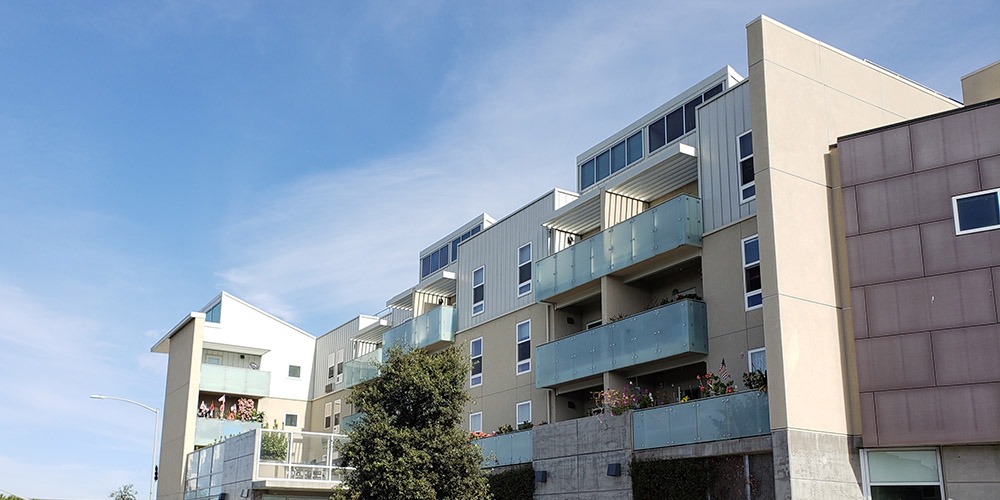
Apartments in downtown Salinas (Photo: agarre16/Wikimedia)
Monterey County, much like the rest of California, is facing a housing crisis that not only affects the unhoused, but also working families who can barely afford to pay for housing or must spend hours commuting to and from work to be able to afford a place to live.
But the region has specific challenges as the Salinas Valley is home to a large agricultural industry that employs low-wage farmworkers, many of them immigrants. According to the National Low Income Housing Coalition, the average Monterey County tenant would need to earn more than $70,000 to be able to afford a two-bedroom unit. But with a median wage of $12.70 per hour, the mean annual income is only $25,000.
That’s why one of the goals of the Regions Rise Together Salinas Investment Blueprint is to create prosperity and inclusivity for all Salinas Valley residents. This means making sure that residents who traditionally have been marginalized, will eventually have stable, accessible and clean housing with strong infrastructure support. It’s part of the overall economic development investment plan that is truly racially equitable.
“Homelessness and housing are two different crises, although they seriously affect each other,” explained Roxanne Wilson, executive officer of Monterey/San Benito Counties Coalition of Homeless Services Providers. Over the next five years, she would like to see a 50% reduction in homelessness (the latest homeless count recorded 2,422 homeless people) and an increase of housing production by at least 1,000 units.
She added, “There are a great number of people who are experiencing homelessness who are of the working class. So, what that tells us is that it’s not really about people who aren’t interested in housing. It’s a clear sign that there is a lack of housing.”
Several factors contribute to the region’s housing crisis including lack of multi-unit housing, an increase in the number of families moving to Monterey County who are commuting to the San Jose area for work (where housing costs are even higher), foreign investors buying property and lack of infrastructure to support an increasing population.
The Regions Rise Together Salinas Investment Blueprint outlines community solutions that include creating a Regional Housing Trust focused on creating gap financing for affordable housing development for farmworker families, the creation of 5,300 additional units for farmworker families, 4,000 affordable housing units for very low-, low- and moderate-income resident renters and 1,000 additional Accessory Dwelling Units (ADUs).
Expanding infrastructure, especially broadband access, will be key to the success of these neighborhoods as education, work and even health appointments depend on connectivity.
“How important is the internet when someone’s entire education is in the hands of having that access?” asked Dr. Carissa Purnell, director of the Alisal Family Resource Center. “Everyone knows the long-term data that, without education, people have lower paying jobs, less access to preventative healthcare and unstable housing. That simple barrier to accessing education was a huge one for us because it trickled down to so many other things.”
Even when areas are shown to be “covered” by internet service providers, there is sometimes little or low-quality coverage. Monterey Bay Economic Partnership (MBEP) Chief Operating Officer Freny Cooper explained, “One example is the San Jerardo housing cooperative outside of Salinas, which according to all the maps, says it’s covered, but people either couldn’t afford the service or were dropping connections on the existing service.”
Cooper points to Equal Access Monterey Bay, a program that is designed to supplement state and federal sources of funding with philanthropic donations for infrastructure projects that would not otherwise break even for ISPs. MBEP and Cruzio Internet partnered on this project to bring reliable wireless internet to the San Jerardo cooperative. Cruzio was awarded a CPUC grant to build the infrastructure needed to connect every home in the cooperative free of charge to the residents. The charitable donations into a Community Foundation for Monterey County fund will provide the internet service costs for the first five years, and thereafter, each household will be charged no more than $15 per month.
The investment for the Neighborhood Development and Infrastructure Expansion focus area of the Regions Rise Together Salinas Investment Blueprint is $385 million, which could come from federal, state and philanthropic sources. The Governor’s 2022-23 budget includes funds that could help achieve the Blueprint goals, including:
- $500 million in Low-Income Housing Tax Credits, of that $4.6 million is for farmworker housing Assistance Tax Credits
- $2 billion over the next two years to expand access to housing for vulnerable populations with complex behavioral health conditions and people living in encampments
- $1.5 billion in General funds over two years dedicated to resources to address the immediate housing and treatment needs of people experiencing homelessness who have behavioral health conditions
- SB 156 invests $6 billion for middle-mile ($3.25 billion) and last-mile ($2 billion) broadband infrastructure as well as well as Financial Backing for Public Networks and Technical Assistance Grants
This is the second part of a four-part series on the Regions Rise Together Salinas Investment Blueprint. The next installment will focus on Human Capital Development, which includes care from cradle to career and beyond.
Part One “A Blueprint For An Equitable Region Rises In California’s Salinas Valley”
Part Three “Closing The Child Care Gap Is Vital To Monterey County Economic Blueprint”
Part Four “Connecting Pathways to Good-paying Jobs Paves Way for Equitable Regional Economy”
Part Five “Model For Opening Opportunity, Closing The Wealth Gap Unfolds On The Central Coast“

